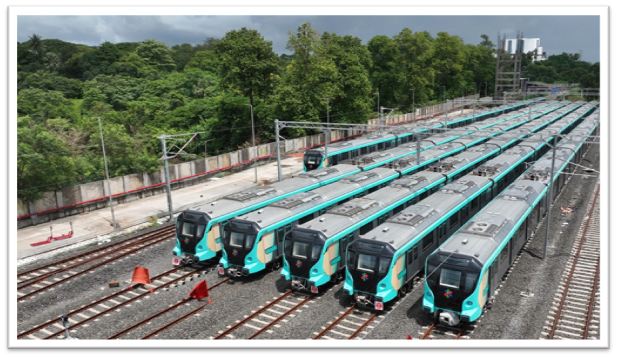
Mumbai Metro Aqua Line 3 Nears Completion: Colaba Set to Welcome Trains After 95 Years
Ninety-five years after the Colaba station on the historic Bombay Baroda and Central India Railway (Western Railway) was decommissioned, South Mumbai is poised to witness the return of trains in a modern avatar. The upcoming Mumbai Metro Aqua Line 3, connecting Aarey JVLR to Cuffe Parade over a 33-kilometer stretch, is set to transform urban commuting in the city’s congested southern corridor. Scheduled for the inauguration of its final stretch between Worli and Cuffe Parade on October 8, the project promises to provide commuters with a faster, more reliable, and environmentally sustainable mode of transport. This milestone underscores Mumbai’s commitment to enhancing urban mobility while modernizing its infrastructure to meet the demands of a growing metropolitan population.
With 27 stations, 26 underground and one at-grade, the Aqua Line 3 has been opened in phases, reflecting meticulous planning and execution. Since October 7, 2024, when the initial 13-kilometer stretch between Aarey JVLR and the Bandra-Kurla Complex (BKC) became operational, approximately 70,000 passengers have benefited from a smoother commute daily. The subsequent 9-kilometer segment from BKC to Acharya Atre Chowk in Worli, inaugurated on May 10, has further eased congestion along critical corridors, demonstrating how phased implementation can effectively balance construction progress with urban mobility needs.
Station Readiness and Urban Impact
A detailed on-site review of all 11 stations along the final stretch reveals substantial progress, with most entry and exit gates nearing completion. At the Science Centre station, three of six gates are expected to be fully operational by October 8, complemented by functioning ticket counters, signage, and escalators. Similarly, stations like Mahalaxmi and Jagannath Shankar Sheth reflect the integration of modern commuter facilities, including escalators, elevators, and CCTV monitoring, while ongoing finishing touches highlight a careful approach to quality assurance.
Several stations, including Grant Road and Girgaon, have undergone rigorous safety drills, ensuring compliance with emergency protocols. Residents and business owners acknowledge the temporary disruptions caused by prolonged construction but anticipate significant long-term benefits. For instance, the Kalbadevi and Girgaon stations are expected to ease persistent traffic congestion, reduce travel times, and provide an organized, accessible alternative to overcrowded roadways. These improvements signify a clear commitment to urban resilience and citizen-centric planning.
Infrastructure and Accessibility Enhancements
Metro Aqua Line 3 is designed with accessibility at its core. Stations such as Hutatma Chowk feature fully concreted ramps with railings, while CSMT station’s gates on Mahapalika Marg provide debris-free, safe entry for passengers. Churchgate, Vidhan Bhavan, and Cuffe Parade stations are also nearing completion, with ongoing efforts focused on finishing surface work and clearing debris, ensuring a safe and welcoming environment for commuters from day one. These thoughtful designs reflect how modern urban infrastructure can enhance both mobility and pedestrian safety in dense metropolitan contexts.
Economic and Social Implications
Beyond improving transportation efficiency, Metro Aqua Line 3 is expected to catalyze economic activity by connecting key commercial, residential, and cultural hubs. While some taxi drivers and small businesses have expressed concerns about changes in passenger patterns, these shifts also present opportunities to diversify services, explore last-mile connectivity solutions, and integrate multi-modal transport strategies. The project exemplifies how modern urban transit initiatives can balance economic considerations with long-term sustainability and citizen convenience.
A Historical and Modern Milestone
The return of trains to Colaba after nearly a century is emblematic of Mumbai’s evolution from its colonial rail heritage to a forward-looking, technologically advanced urban transport network. By integrating underground and at-grade stations, advanced safety systems, and commuter-friendly amenities, Aqua Line 3 sets a benchmark for future metro projects in India. It demonstrates how careful planning, phased execution, and community engagement can collectively deliver world-class infrastructure while mitigating urban challenges.
Conclusion: A Transformational Leap for South Mumbai
The Mumbai Metro Aqua Line 3 is more than just a transportation project—it is a transformative urban development endeavour that redefines commuting, enhances connectivity, and fosters sustainable growth. By addressing congestion, improving accessibility, and integrating modern infrastructure, it promises to significantly enhance the quality of life for South Mumbai residents. As the city prepares to witness trains returning to Colaba after 95 years, the Aqua Line 3 stands as a testament to strategic planning, resilient engineering, and a vision for a more connected, efficient, and liveable Mumbai.





